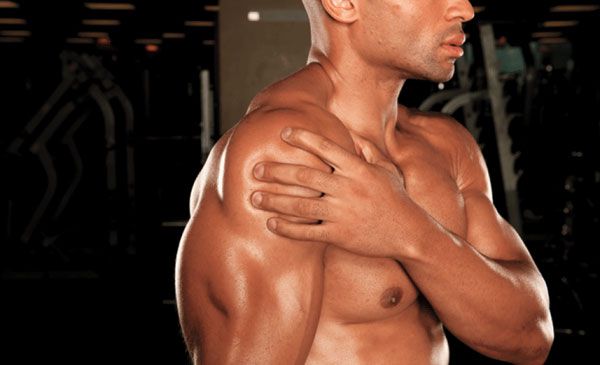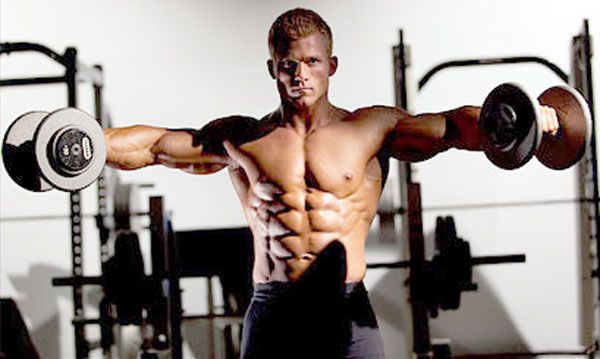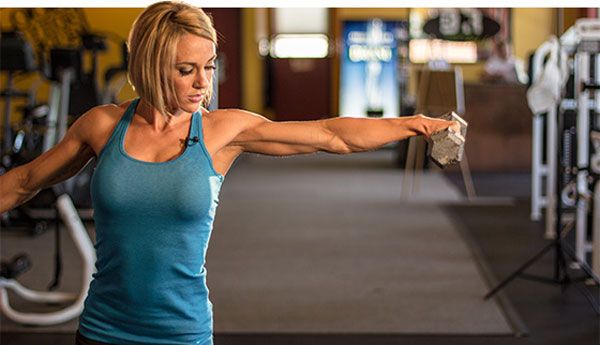There are many exercises for training the deltoids. Standing dumbbell breeding or wiring is one of them. Technically, this is a simple move, but it is often done incorrectly. As a result, a person not only does not get the desired result, but can also injure the shoulder.
Muscle work
In this exercise, the shoulder muscles work in isolation. The main load falls on the middle or lateral bundles of deltoids. Deltas are small and easily injured. Therefore, when performing exercises, it is important to select weights carefully, without unnecessary haste. Correct movement is also required.
If you do dumbbell breeding while standing or sitting with a violation of the technique, then load the non-target muscles and increase the risk of tears and sprains.
Shoulder vulnerability
Anyone who has injured the deltoid muscle at least once in their life knows why this can happen. Moreover, there are times when a person warmed up enough, smoothly approached the working weight (for example, in the bench press). And during one of the repetitions I felt pain.
The deltoids are not very well located. When moving, the tendons rub against the bone, gradually erasing their surface. This leads to inflammation of their membranes. Tears are due to improper technique, poor warm-up and other irregularities. But inflammation is due to such features of the shoulders.

Standing dumbbells are also a relatively traumatic element of working with shoulders. Therefore, technique is at the forefront.
Another reason that deltoids are most often injured is their congestion.
When exercising in the hall, deltas work during all barbell presses and dumbbells, breeding at all angles. Therefore, when you swing your chest, your shoulders work. You swing the triceps with the base – they work the same. You do push-ups on the uneven bars or pull-ups – and then your shoulders turn on. In the first case, of course, more. When pulling up, the back bundle of deltoids is involved. In any case, raising arms on such days is not a good idea.
Rules for training deltas
In order for the shoulders to serve us longer and better, we need to adhere to certain recommendations when you do a standing-up dumbbell lift (it is better not to do it while sitting, as the legs in this position will interfere with the correct reduction of the dumbbells):
- Dose the load. If you had bench presses, spreads and other presses today, you cannot train the front and middle deltoid bundles.
- If today you did exercises on the back, then you loaded the rear deltoids. Train the front and middle beams if you want to do deltoids on this particular day.
The best shoulder workout option is leg day. On this day, purely legs work, and on the shoulders you can give a complex load, starting from the bench press, and ending with raising the dumbbells while standing.
Technique for performing dilutions
To begin with, let’s recall that lifting dumbbells through the sides (spreading) is aimed at strengthening and training the lateral (middle) bundle of deltoids. If you do this exercise incorrectly, the load is transferred to the front beam. And if it is completely wrong, then on the back one (you need to try for this).

If done incorrectly, raising the dumbbells to the sides while standing redistributes the load on the upper part of the trapezius muscles, which is not OK. Dumbbell Lateral Raising is an isolated exercise for the lateral deltas, and nothing else.
Before training, you need to thoroughly warm up your shoulder joints.
The technique for performing the exercise is as follows:
- Choose a place in front of the mirror, you will need to face it … Take a small weight – 3-4 kg. Now we will learn how to properly swing with dumbbells while standing. By the way, the correct name of the exercise is to raise dumbbells through the sides while standing, but it is often called wiring and swinging, and much like that.
- Spread your shoulders, put your feet hip-width apart. Look straight into your face in the mirror. Bend your arms slightly at the elbows (the angle remains unchanged throughout the exercise) and lower them to the sides of the body. The hands will come out slightly forward, as your elbows are bent.
- The dumbbells should be taken so that the palms are turned towards the body. This is the starting position.
- Now attention: start the abduction so that the elbows are turned back and up. Raise your hands to parallel with the floor. Some call this exercise “jugs” because the movement is like pouring water out of jugs. If your elbows are not pointing up, you will not turn your arms so that water spills out of the jugs. Imagine that the dumbbells are jugs.
- Hold this position for 1-2 seconds and lower your arms back.
Repeat the light abduction 10-15 times for warm-up. Then work with the necessary weights.
We do the abductions of the arms without jerking, solely by the effort of the deltoids, without changing the angle of flexion at the elbow. We stop when our hands reach a line parallel to the floor.
Using one dumbbell
Swinging dumbbells to the sides while standing can be done with one dumbbell. When the second one is busy, or there is only one dumbbell with this weight in the gym, the one-arm option will help you out a lot. We recommend that you hold on to some kind of support with your other hand in order to exclude unnecessary vibrations of the body.
Lateral lifting of dumbbells with one hand, as well as breeding, it is more convenient to do while standing, rather than sitting.

Features of the exercise
Below are a number of points to look out for when incorporating the exercise into your training program:
- Side Dumbbell Raises (spread) are done with a precisely adjusted weight. If the weight is small, you will not get the effect. If it is too big, the technique will suffer – you will bend your elbows even more to facilitate the exercise.
- If you raise your arms with dumbbells higher than parallel to the floor, the trapezius muscles are included in the work. Do this if you plan to train trapeziums.
- If you swing your arms with your elbows down, the load will be distributed between the front and middle bundles of deltoids. As a result, you will not pump either one or the second.
- If you do swings with your hands with cheating, for example, from a jump, there will be no sense either. Damage the tendons faster.
- Raise the arms as you exhale, and return to the starting position as you inhale.
- On the last rep, you can linger at the top point for 5-10 seconds. This will strengthen your shoulders.
- To check your technique, take one approach while standing sideways to the mirror. Pay attention to whether you are slouching. Is the lower back arched correctly?
- For greater efficiency, do not relax the muscles at the bottom point and lower the dumbbells on the hips. Keep them at some distance so that the deltoids do not rest during the exercise.
- There are no hands during supination abduction. The arms are fixed. Only the shoulders work. The hands are slightly lower than the elbows. This position will allow you to “pour water out of the jugs” at the top.
